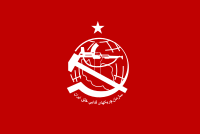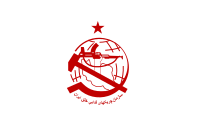Organization of Iranian People's Fedai Guerrillas
Organization of Iranian People's Fedai Guerrillas سازمان چريکهای فدايی خلق ايران | |
|---|---|
 | |
| Abbreviation | OIPFG[1] |
| Spokesperson | Mehdi Fatapour[2] |
| Secretary of the Central Committee | Farrokh Negahdar[3] |
| Founded | late 1963 initial activity[4] April 1971 as the unified organization[1] |
| Dissolved | June 1980[5] |
| Merger of | Jazani-Ẓarifi Group and Aḥmadzāda-Puyān-Meftāḥi Group[1] |
| Succeeded by | Organization of Iranian People's Fedaian (Majority) Organization of Iranian People's Fedai Guerrillas (Minority) Iranian People's Fedai Guerrillas |
| Headquarters | Tehran, Iran |
| Newspaper | [5] |
| Ideology | Communism Marxism–Leninism |
| Political position | Far-left[6] |
| Colors | Red |
| Anthem | Aftabkaran-e-Jangal (lit. 'Sunplanters of Jungle')[7] |
| Party flag | |
  | |
| |
| Leaders | Hamid Ashraf (KIA) Ashraf Dehghani (POW) |
|---|---|
| Dates of operation | 1971–1976[8] 1977[9]–1980 |
| Group(s) | Urban team, rural team[4] |
| Size | 3,000 (estimate)[6] |
| Allies | |
| Opponents | |
| Battles and wars | Siahkal incident |
The Organization of Iranian People's Fedai Guerrillas (OIPFG; Persian: سازمان چريکهای فدايی خلق ايران, romanized: Sāzmān-e čerikhā-ye Fadāʾi-e ḵalq-e Irān), simply known as Fadaiyan-e-Khalq (Persian: فداییان خلق, romanized: Fadāʾiān-e ḵalq, lit. 'Popular Selfsacrificers')[9] was an underground Marxist–Leninist guerrilla organization in Iran.[1]
Ideology[]
Ideologically, the group pursued an Anti-imperialist agenda and embraced armed propaganda to justify its revolutionary armed struggle against Iran's monarchy system,[11] and believed in Materialism.[8] They rejected reformism, and were inspired by thoughts of Mao Zedong, Che Guevara, and Régis Debray.[5]
They criticized the National Front and the Liberation Movement as "Petite bourgeoisie paper organizations still preaching the false hope of peaceful change".[4] Fedai Guerrillas initially criticized the Soviet Union and the Tudeh Party as well, however they later abandoned the stance as a result of cooperation with the socialist camp.[5]
Bijan Jazani, known as the "intellectual father" of the organization, contributed to its ideology by writing a series of pamphlets such as "Struggle against the Shah's Dictatorship", "What a Revolutionary Must Know" and "How the Armed Struggle Will Be Transformed into a Mass Struggle?". The pamphlets were followed by Masoud Ahmadzadeh's treatise "Armed Struggle: Both a Strategy and a Tactic" and "The Necessity of Armed Struggle and the Rejection of the Theory of Survival" by Amir Parviz Pouyan.[4]
Electoral history[]
| Year | Election | Seats won |
|---|---|---|
| 1979 | Constitutional Assembly | 0 / 73 (0%)
|
| 1980 | Parliament | 0 / 290 (0%)
|
Leadership[]
The group was governed by collective leadership. Before the Iranian Revolution, its six-members leadership did not use the term 'central committee'.[12]
|
|
See also[]
- Guerrilla groups of Iran
- Organization of Iranian People's Fedai Guerrillas (1963–1980)
- Iranian People's Fedai Guerrillas (1979–present)
- Organization of Iranian People's Fedaian (Majority) (1980–present)
- Organization of Iranian People's Fedai Guerrillas (Minority) (1980–1987)
- Organization of Iranian People's Fedai Guerrillas – Followers of the Identity Platform (1983–present)
- Organization of Iranian People's Fedai Guerrillas (1985–present)
- Fedaian Organisation (Minority) (1987–present)
References[]
- ^ Jump up to: a b c d Vahabzadeh, Peyman (28 March 2016) [7 December 2015]. "FADĀʾIĀN-E ḴALQ". In Yarshater, Ehsan (ed.). Encyclopædia Iranica. Bibliotheca Persica Press. Retrieved 1 August 2016.
- ^ Vahabzadeh, Peyman (2010). Guerrilla Odyssey: Modernization, Secularism, Democracy, and the Fadai Period of National Liberation In Iran, 1971–1979. Syracuse University Press. p. 67. ISBN 9780815651475.
- ^ Muhammad Kamal (1986). "Iranian Left in Political Dilemma". Pakistan Horizon. Karachi: Pakistan Institute of International Affairs. 39 (3): 39–51. JSTOR 41393782.
- ^ Jump up to: a b c d Abrahamian, Ervand (1982). Iran Between Two Revolutions. Princeton University Press. pp. 483–9. ISBN 0-691-10134-5.
- ^ Jump up to: a b c d Ḥaqšenās, Torāb (27 October 2011) [15 December 1992]. "COMMUNISM iii. In Persia after 1953". In Yarshater, Ehsan (ed.). Encyclopædia Iranica. Fasc. 1. VI. New York City: Bibliotheca Persica Press. pp. 105–112. Retrieved 12 September 2016.
- ^ Jump up to: a b Donald Newton Wilber (2014). Iran, Past and Present: From Monarchy to Islamic Republic. Princeton University Press. p. 344. ISBN 978-1400857470.
- ^ Annabelle Sreberny, Massoumeh Torfeh (2013), Cultural Revolution in Iran: Contemporary Popular Culture in the Islamic Republic, I.B. Tauris, p. 156, ISBN 9781780760896CS1 maint: uses authors parameter (link)
- ^ Jump up to: a b Mahmood T. Davari (2004). The Political Thought of Ayatollah Murtaza Mutahhari: An Iranian Theoretician of the Islamic State. Routledge. p. 61. ISBN 978-1-134-29488-6.
- ^ Jump up to: a b Hiro, Dilip (2013). "Fedai Khalq". A Comprehensive Dictionary of the Middle East. Interlink Publishing. pp. 483–9. ISBN 9781623710330.
- ^ Jump up to: a b c Arie Perliger, William L. Eubank (2006), "Terrorism in Iran and Afghanistan: The Seeds of the Global Jihad", Middle Eastern Terrorism, Infobase Publishing, pp. 41–42, ISBN 9781438107196CS1 maint: uses authors parameter (link)
- ^ Vahabzadeh, Peyman (2010). Guerrilla Odyssey: Modernization, Secularism, Democracy, and the Fadai Period of National Liberation In Iran, 1971–1979. Syracuse University Press. p. 100.
- ^ Jump up to: a b c d Maziar, Behrooz (2000). Rebels with a Cause: The Failure of the Left in Iran. I.B.Tauris. p. 209. ISBN 1860646301.
- Defunct communist militant groups
- Defunct communist parties in Iran
- Guerrilla organizations
- Political parties of the Iranian Revolution
- Militant opposition to the Pahlavi dynasty
- Banned communist parties
- Banned political parties in Iran
- Militant opposition to the Islamic Republic of Iran
- Far-left political parties
- Marxist organizations
- Left-wing militant groups in Iran
- Paramilitary organisations based in Iran